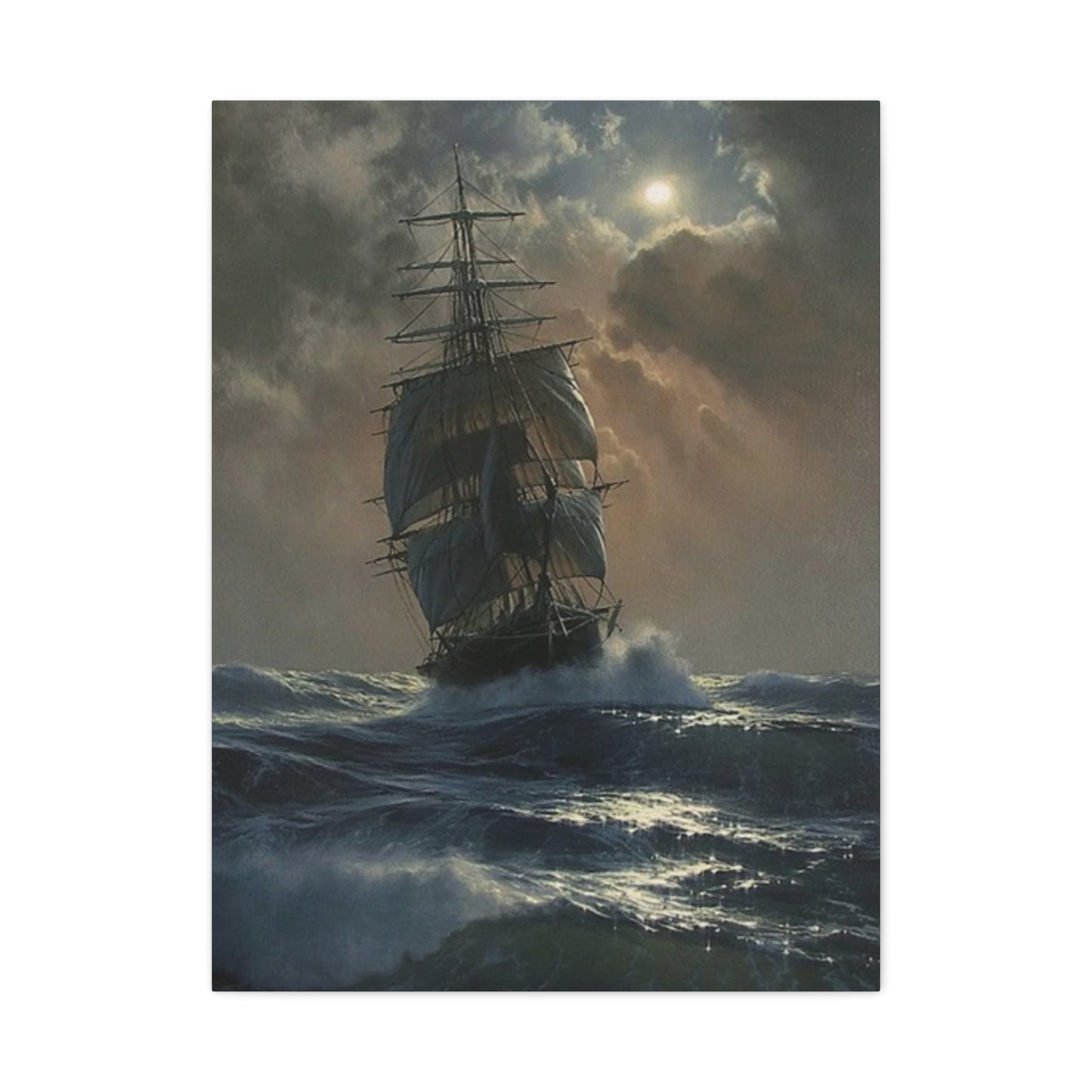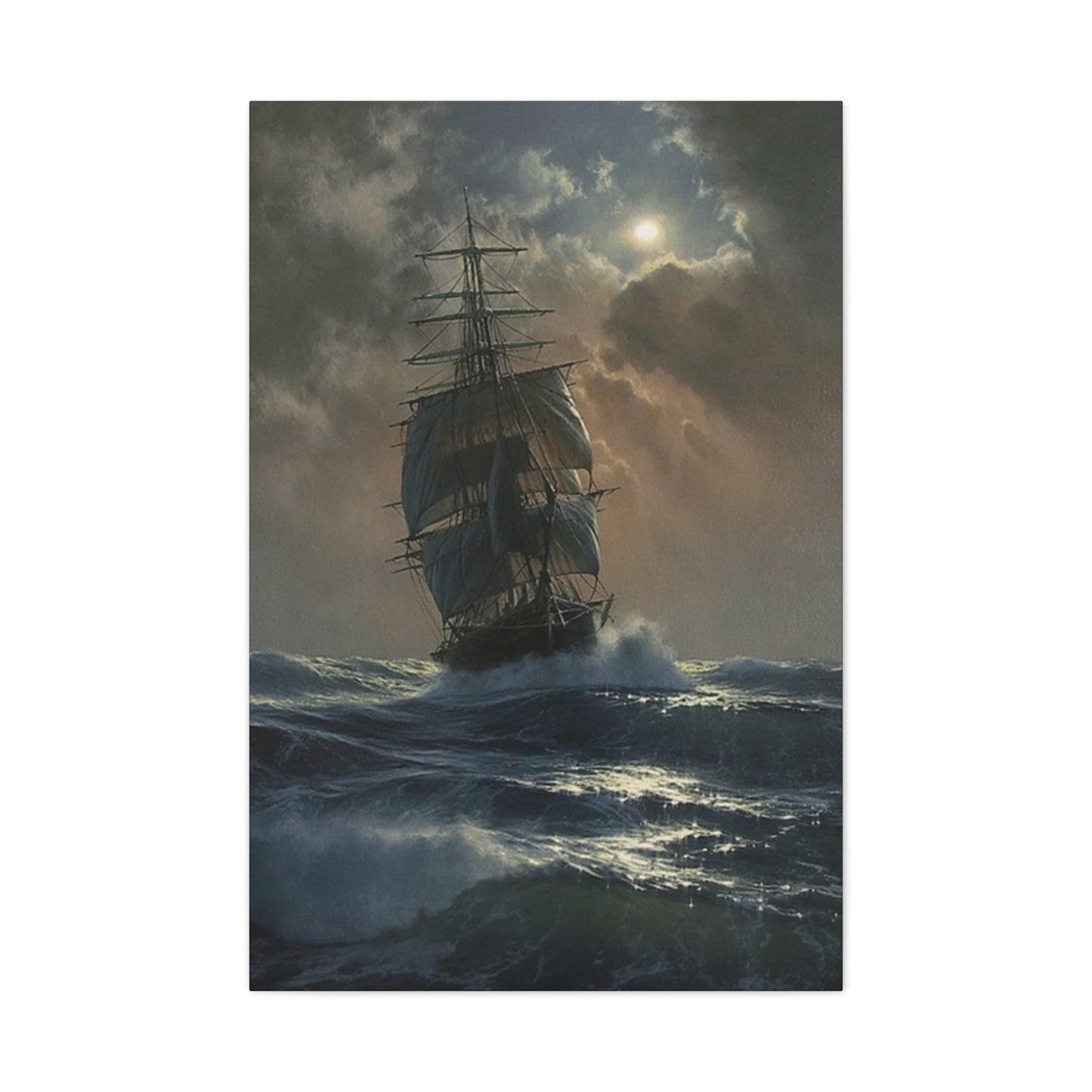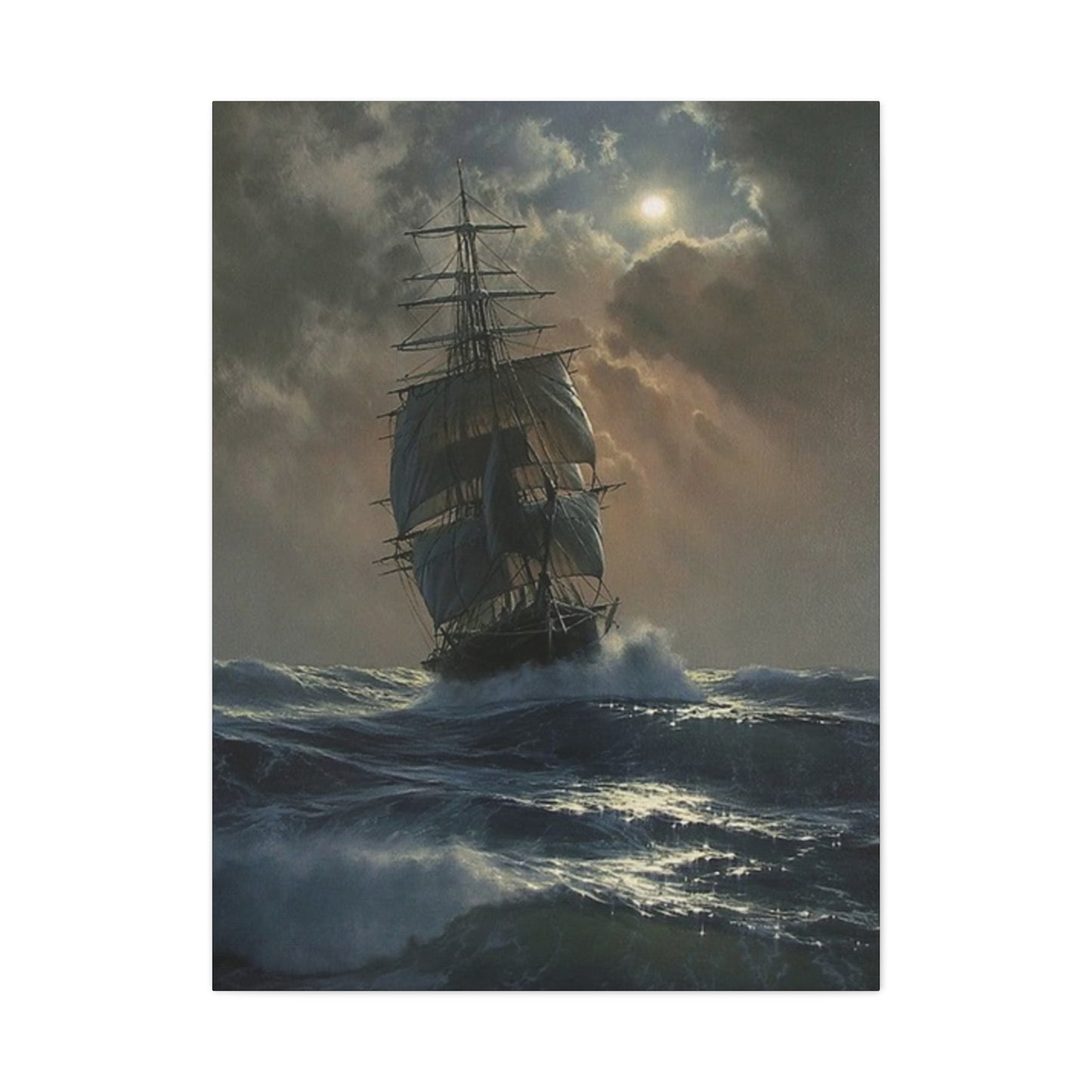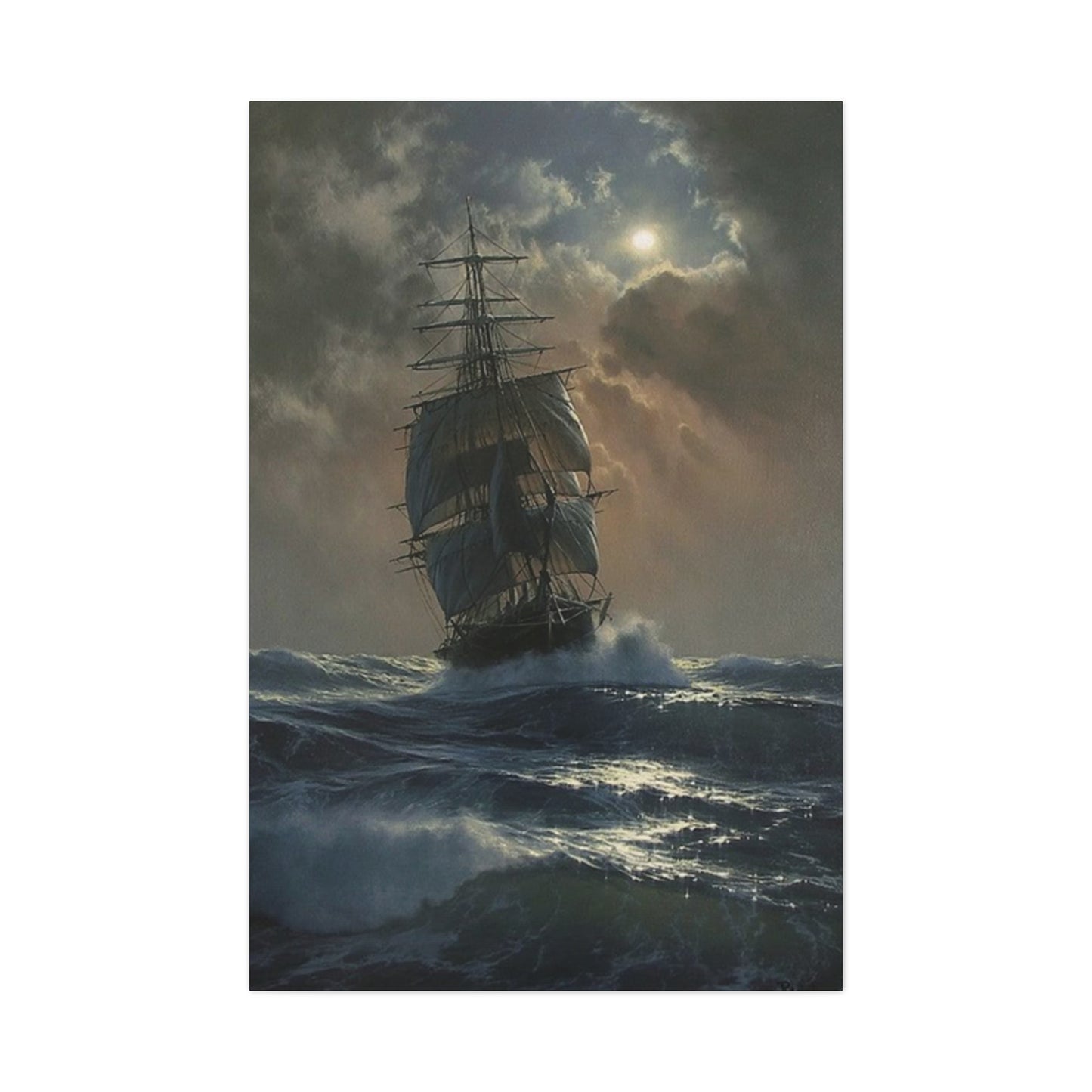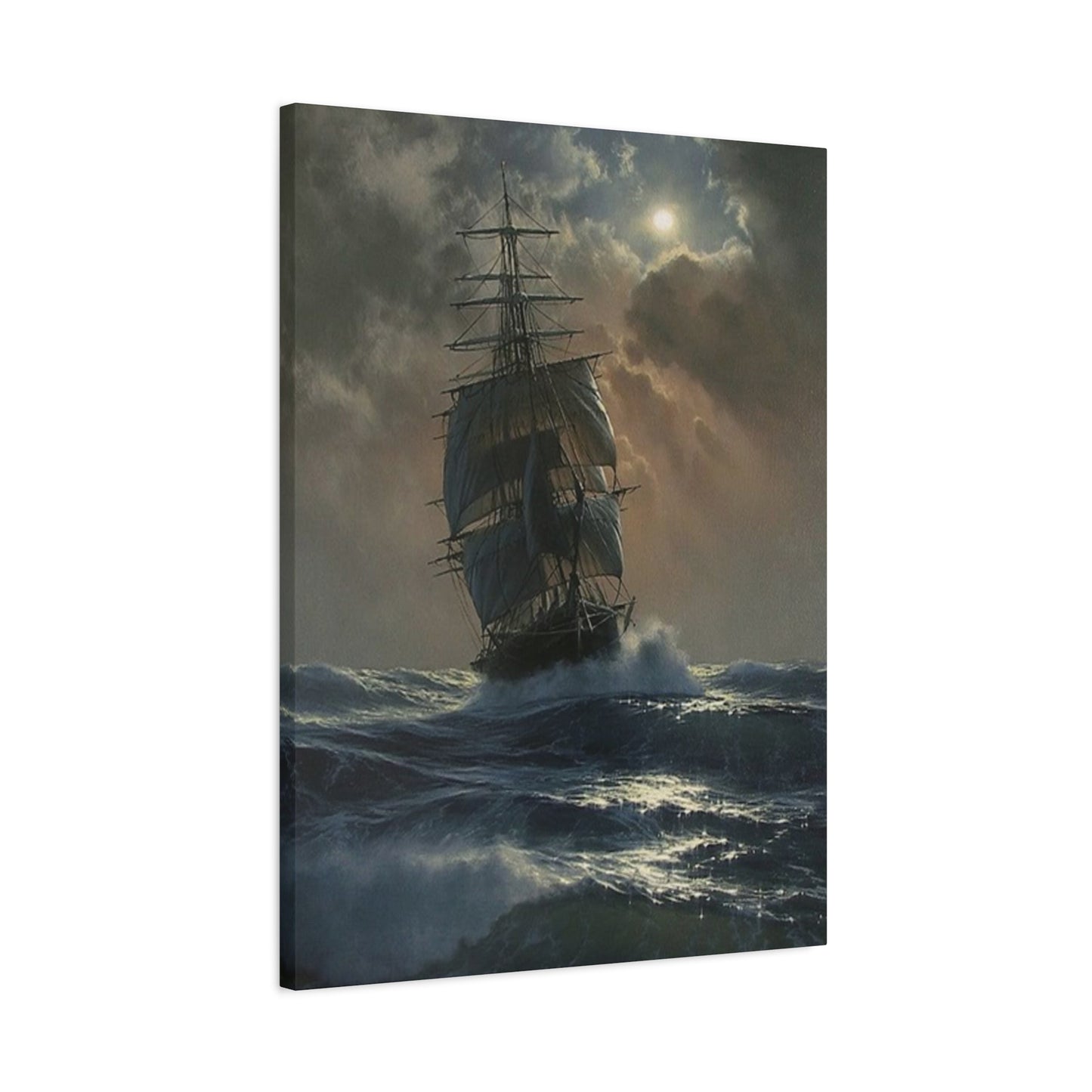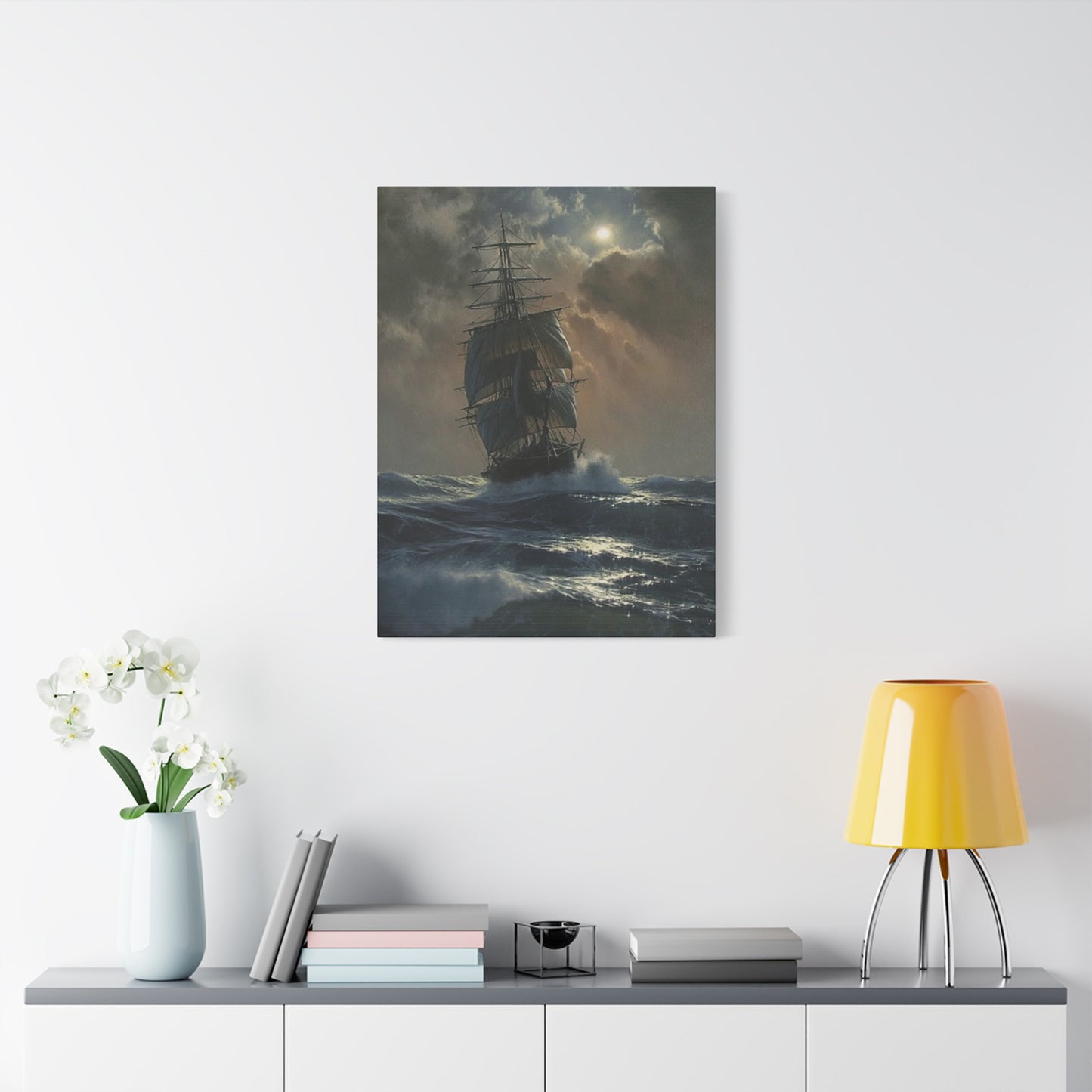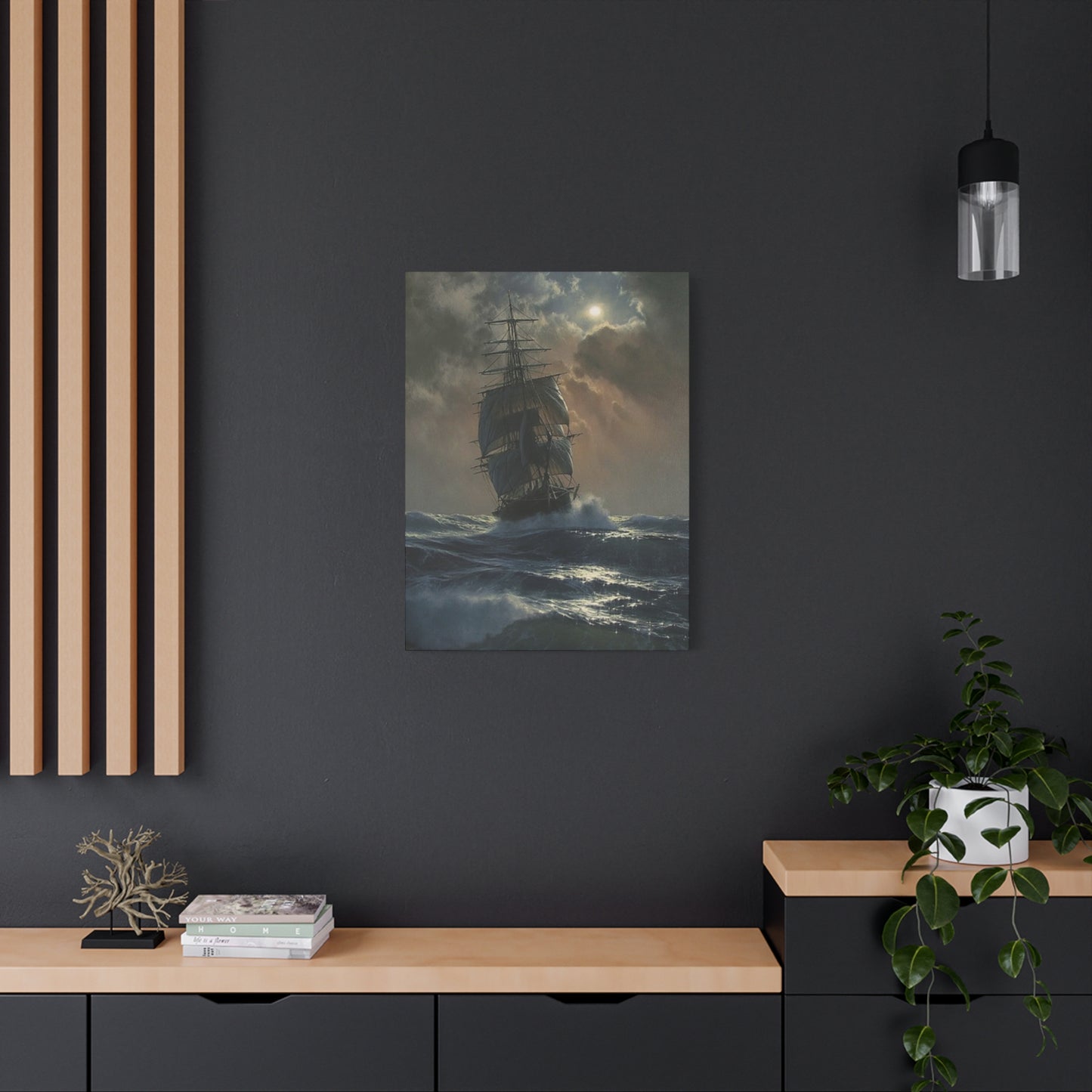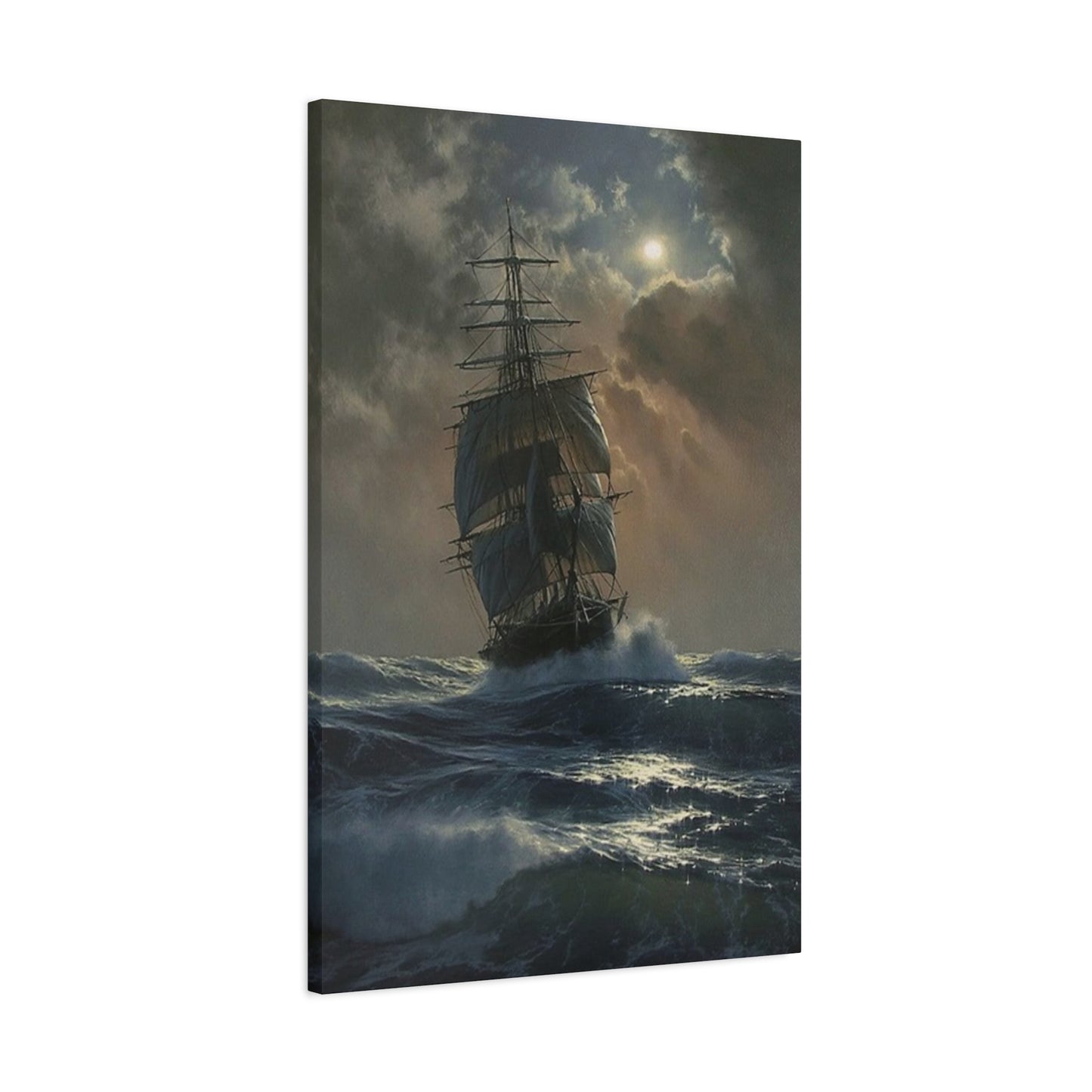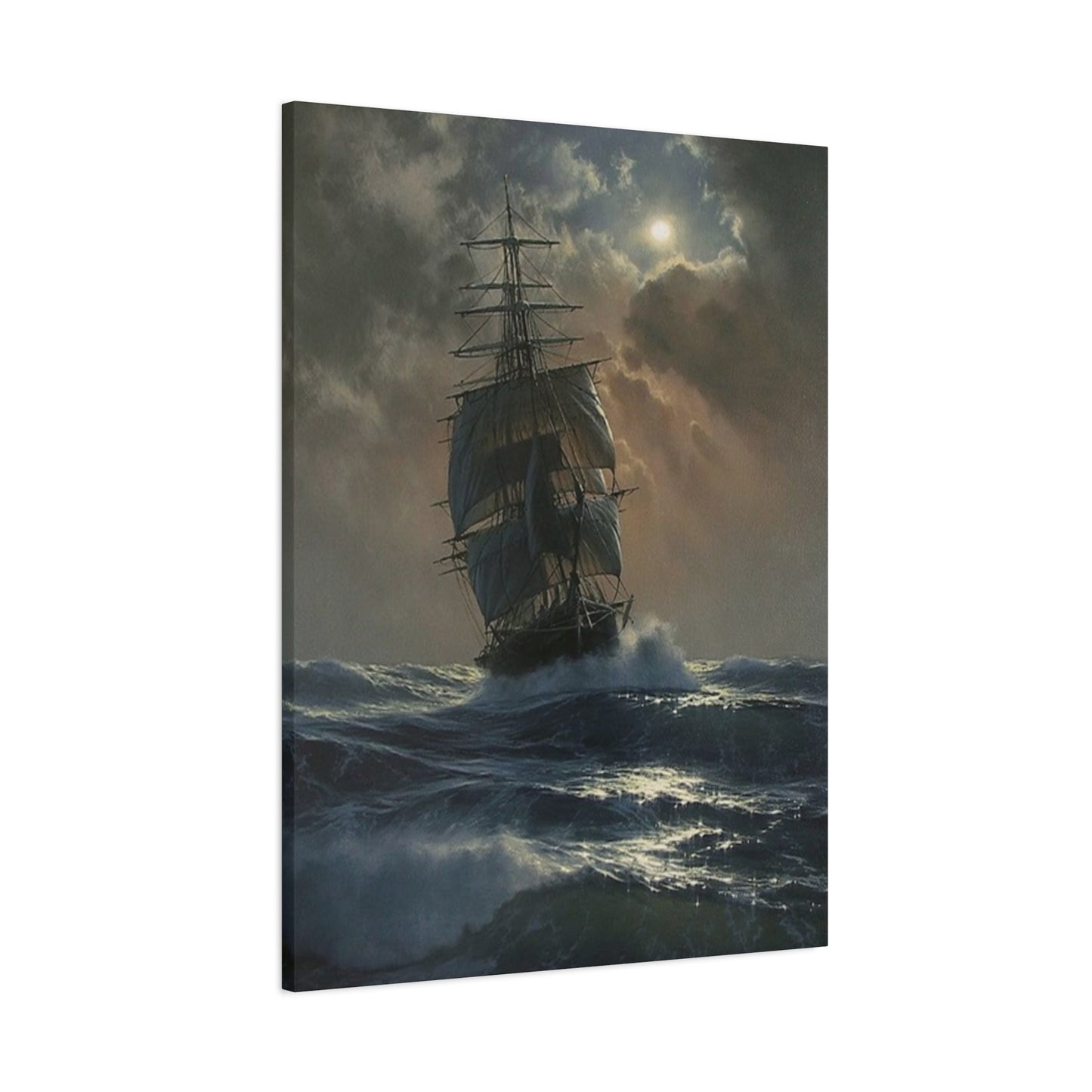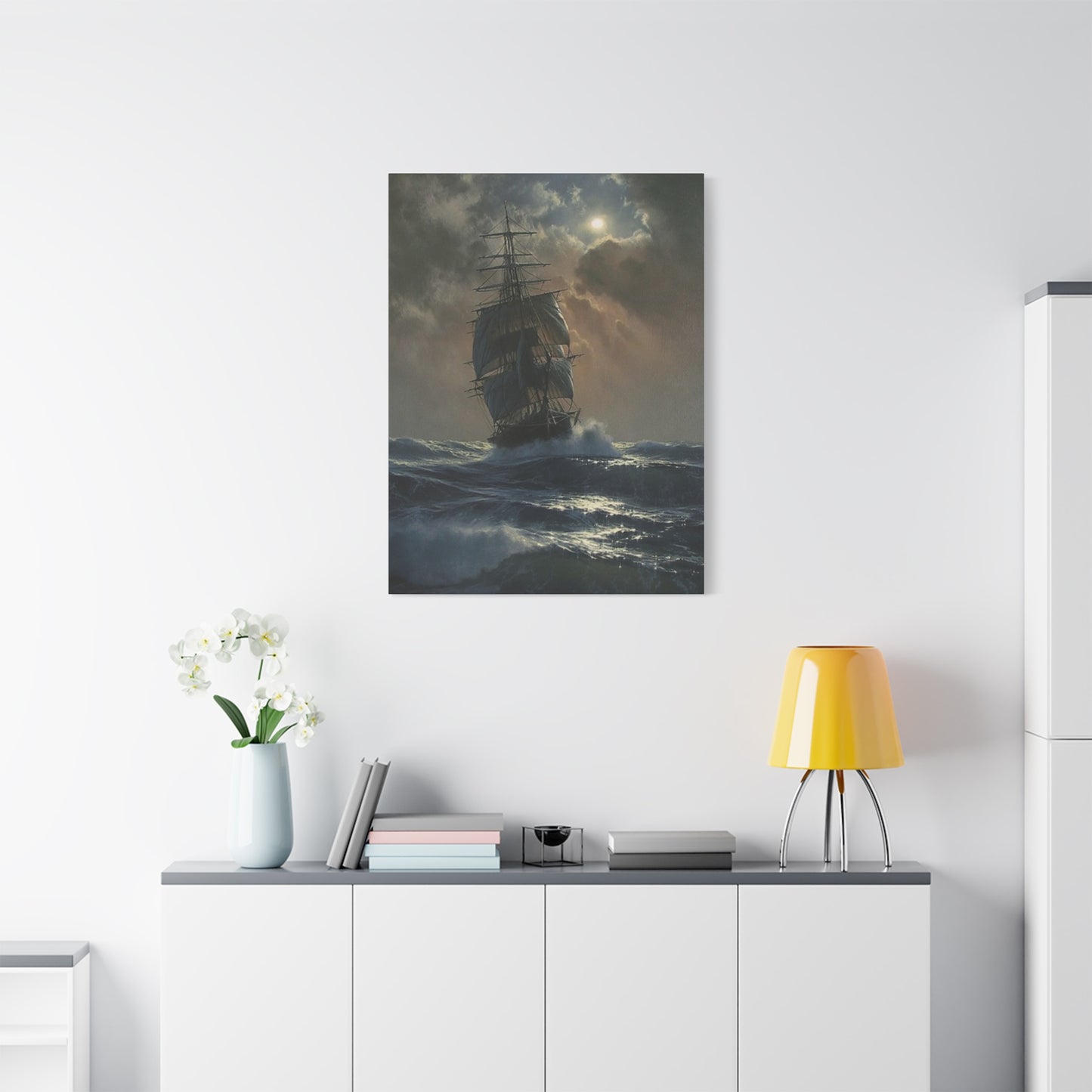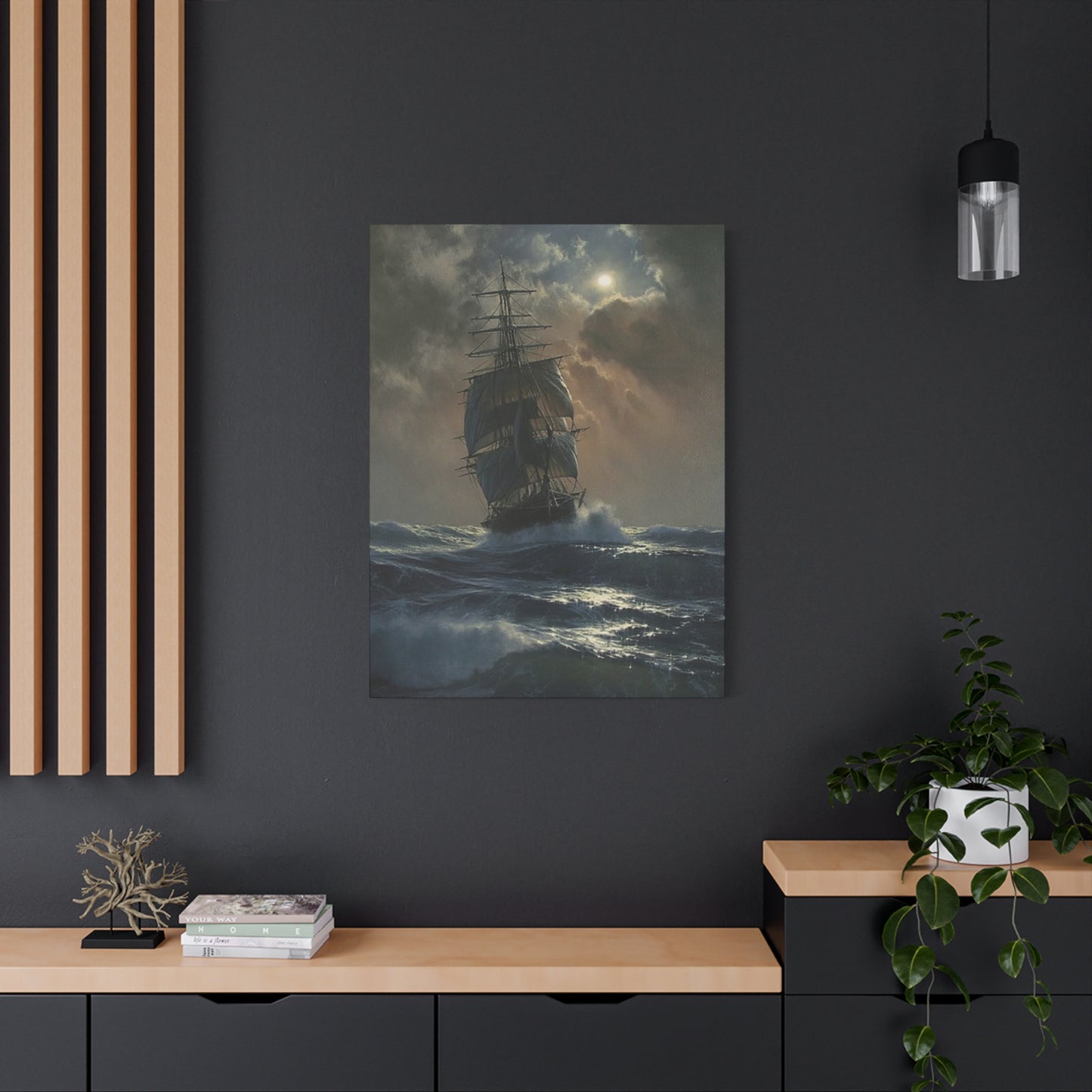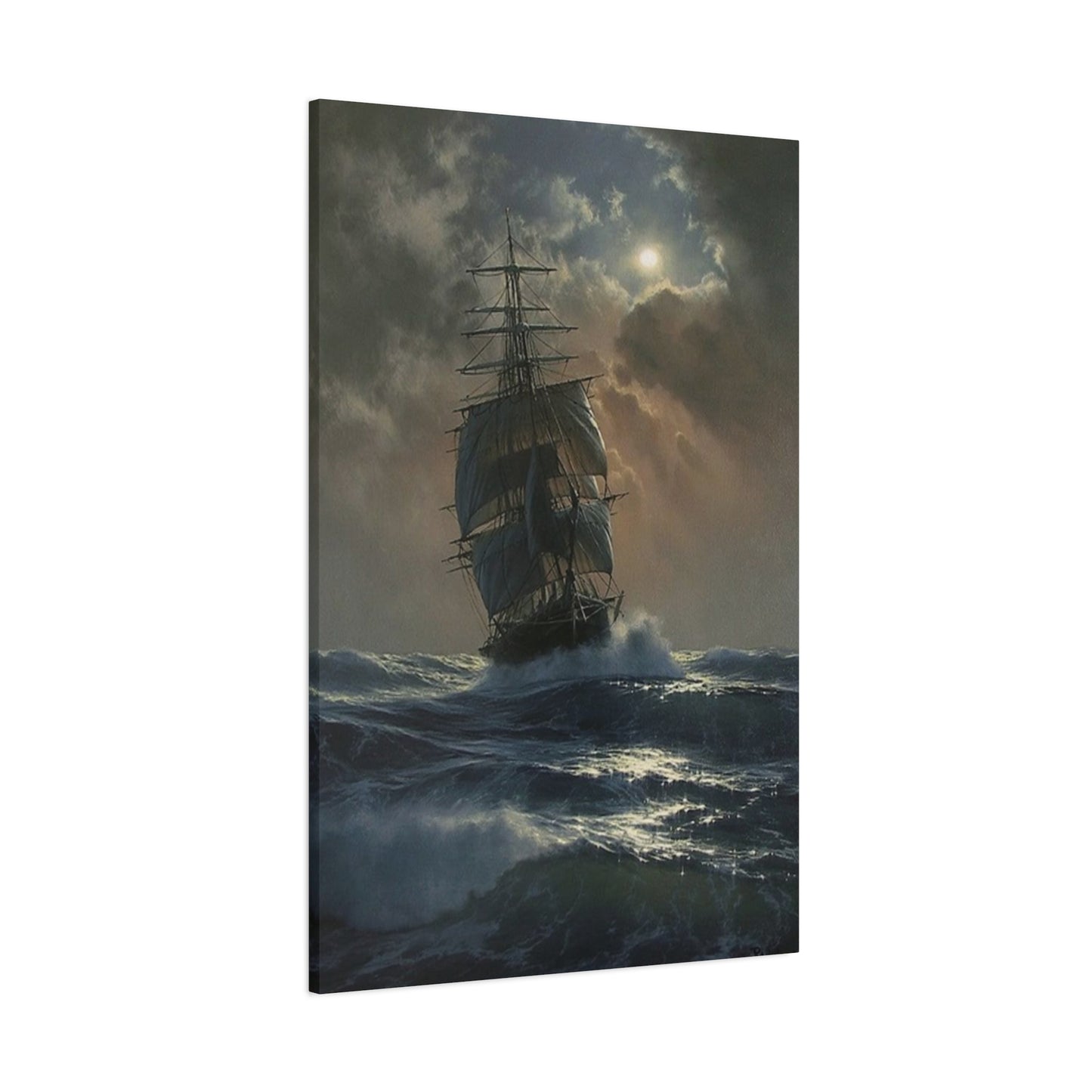Night Ship Wall Art: Bringing Oceanic Serenity and Drama to Your Living Space
When it comes to decorating your home with pieces that evoke emotion, tranquility, and a sense of adventure, few artistic choices can match the captivating appeal of nocturnal maritime imagery. The visual representation of vessels navigating through darkened waters beneath celestial bodies creates an atmosphere that is simultaneously peaceful and dramatic. This type of artwork has gained significant popularity among homeowners and interior designers who seek to infuse their spaces with depth, character, and a touch of wanderlust.
The combination of shadowy ocean expanses, illuminated by moonlight or starlight, with the silhouette of a sailing vessel creates a powerful visual narrative. These pieces speak to something primal within us, connecting to humanity's ancient relationship with the sea and our eternal fascination with nocturnal beauty. Whether you are looking to establish a focal point in your living room, create a meditative atmosphere in your bedroom, or add sophistication to your office space, this genre of artwork offers endless possibilities.
Throughout this extensive exploration, we will delve into every aspect of incorporating maritime nocturnal imagery into your interior design scheme. From understanding the psychological impact of these visuals to practical styling tips, color coordination, room-by-room applications, and current trends that are shaping the way people decorate in 2025, this resource will provide you with all the information you need to make informed decisions about bringing the mystery and beauty of nighttime seascapes into your home.
Refined Maritime Decoration with Nocturnal Ocean Compositions
Elegance in interior design is characterized by restraint, quality, and timeless beauty. Refined spaces avoid trends in favor of classic elements that will remain beautiful for years to come. Nocturnal ocean scenes with nautical elements are exceptional choices for elegant interiors because they possess inherent sophistication while avoiding the stuffiness that can sometimes afflict more traditional elegant decor.
The nautical theme has long been associated with refinement and class. Maritime imagery evokes yacht clubs, seaside estates, and the golden age of sail, all settings associated with leisure, culture, and sophistication. However, traditional nautical decor can sometimes veer into cliché territory with overused motifs like anchors, stripes, and life preservers. Nocturnal maritime artwork offers a more subtle, sophisticated approach to the nautical theme. It references the ocean and sailing without relying on obvious symbols, making it suitable for elegant spaces where subtlety is valued.
The color palette of nighttime ocean scenes naturally aligns with elegant design principles. The deep blues, blacks, and grays that dominate these pieces are all colors associated with sophistication and maturity. They are the colors of evening wear, luxury cars, and high-end design. When incorporated into interior spaces, these colors automatically elevate the perceived elegance of the environment. The absence of bright, primary colors keeps the palette refined and mature.
Quality matters tremendously in elegant spaces, and this extends to artwork. When selecting nocturnal maritime pieces for refined interiors, attention should be paid to the quality of the image reproduction, the materials used for printing, and the framing choices. Canvas prints should be high resolution with excellent color accuracy and depth. Framing should be equally thoughtful, with options like sleek black frames, metallic finishes, or even high-quality frameless mounting systems that allow the artwork to speak for itself without distraction.
In elegant nautical spaces, the nocturnal maritime artwork should be part of a cohesive design scheme rather than existing in isolation. This means considering how the colors, themes, and style of the artwork relate to other elements in the room. Furniture should be carefully selected for both comfort and visual appeal. Materials like leather, velvet, and high-quality wood contribute to an elegant atmosphere. Hardware and fixtures should be substantial and well-made, avoiding anything that appears cheap or flimsy.
Accessories in elegant nautical spaces should be chosen with the same care as the artwork itself. Rather than numerous decorative objects, select a few high-quality pieces that complement the maritime theme. This might include a beautiful vintage sextant, a high-end model ship, or a collection of leatherbound books on maritime history. Each item should be something you genuinely appreciate rather than simply filling space, the goal is curated sophistication, not cluttered decoration.
The layout and balance of the room contribute significantly to its elegance. Symmetry often plays a role in elegant design, creating a sense of order and intentionality. This might mean centering the nocturnal maritime artwork above a sofa or fireplace, flanking it with matching table lamps or sconces, or balancing it with other artwork or architectural features in the room. Even in asymmetrical designs, there should be a sense of visual balance that prevents the space from feeling chaotic or unplanned.
Elegant nautical spaces with nocturnal ocean imagery work beautifully in various rooms throughout the home. A study or library can become a refined retreat with a large maritime piece above the desk or seating area. A dining room gains sophistication and interest from a dramatic nocturnal seascape on the wall. Even bathrooms can be elevated with carefully selected maritime artwork, creating a spa-like atmosphere reminiscent of luxury seaside resorts.
Deep Blue and Dark Tones for Contemporary Visual Pieces
Modern interior design has increasingly embraced darker, more dramatic color palettes, moving away from the all-white, light-filled spaces that dominated for many years. This shift has created perfect conditions for the incorporation of nocturnal maritime artwork, which naturally features the deep blues and black tones that are now highly sought after in contemporary design.
The appeal of darker palettes in modern spaces is multifaceted. Dark colors create a sense of enclosure and intimacy that makes rooms feel cocooning and comfortable despite their contemporary styling. They provide a sophisticated backdrop that allows other design elements to stand out. They also hide imperfections and create a sense of depth that lighter colors cannot achieve. Nocturnal maritime artwork with its inherent dark palette fits seamlessly into these contemporary dark-toned spaces.
Black, particularly matte black, has become a signature color in modern design. It appears in everything from window frames to cabinetry to decorative accessories. Artwork featuring significant areas of black or very dark blue naturally coordinates with these elements, creating a cohesive design scheme. The black in nocturnal seascapes reads as intentional and sophisticated rather than empty or void because it represents the night sky or dark ocean waters, it has meaning and depth.
Deep blue tones ranging from navy to midnight blue serve as the perfect bridge between black and more traditional colors. These blues are cool and sophisticated but less stark than pure black. In contemporary spaces, these deep blues might appear in upholstery, accent walls, or tiles. Nocturnal maritime artwork that features these tones creates harmony with these design elements while adding the additional interest of composition and subject matter.
The contrast between dark tones and lighter elements is crucial in contemporary design. Just as nocturnal maritime artwork features points of light against darkness, modern interiors using dark palettes need lighter elements to prevent them from feeling oppressive. This might mean light-colored flooring, white or cream furniture, or strategic use of metallic finishes that reflect light. The artwork itself demonstrates this principle, showing how darkness and light can coexist beautifully to create visual drama and interest.
Contemporary minimalism benefits particularly from nocturnal maritime artwork. Minimalist spaces can sometimes feel cold or sterile, lacking personality and warmth. A well-chosen piece of artwork can solve this problem by adding a focal point and emotional resonance without cluttering the space or compromising the minimalist aesthetic. A large-scale nocturnal seascape provides that focal point, drawing the eye and giving the room character while maintaining the clean, uncluttered aesthetic that defines minimalism.
The modern emphasis on natural elements and biophilic design also supports the use of maritime artwork. Biophilic design is based on the principle that humans have an innate connection to nature and that incorporating natural elements into our living spaces supports our wellbeing. Ocean imagery, even nocturnal ocean imagery, connects us to nature and the natural world. It brings the outside in, fulfilling biophilic design principles while maintaining a contemporary, sophisticated aesthetic.
Texture plays an important role in contemporary spaces featuring dark color palettes. Since much of the visual impact comes from color and form rather than pattern, texture becomes crucial for creating interest and preventing monotony. This principle applies to artwork as well. Canvas texture, brushstroke texture in painted pieces, or the texture of alternative printing media like metal or acrylic all contribute to the tactile appeal of the space. When selecting nocturnal maritime artwork for contemporary settings, considering the texture and finish of the piece is just as important as considering the image itself.
Revitalizing Bare Surfaces with Nocturnal Sailing Imagery
Empty walls are missed opportunities. They are spaces that could be contributing to the beauty, atmosphere, and personality of your home but instead stand blank and unremarkable. Nocturnal sailing imagery offers an effective solution to the empty wall dilemma, providing visual interest, emotional resonance, and decorative impact that can completely change how a space feels.
The first step in addressing an empty wall is assessing the space itself. Consider the size of the wall, the amount of light it receives, and the existing colors and style of the room. Large walls can accommodate large-scale pieces or gallery wall arrangements, while smaller walls might be better suited to medium-sized single pieces. Walls that receive significant natural light can handle darker artwork without the space feeling too dim, while walls in darker corners of a room might benefit from pieces that include more light elements, such as prominent moons or starry skies.
Scale is crucial when selecting artwork for empty walls. A piece that is too small will look lost and insignificant, failing to provide the impact needed to justify its presence. A piece that is too large can overwhelm the space and make the room feel smaller and more crowded. As a general rule, artwork should take up roughly two-thirds to three-quarters of the available wall space above furniture, or if hung on a wall without furniture below, should be substantial enough to stand as its own visual statement without appearing dwarfed by the wall.
Nocturnal sailing imagery comes in various sizes and formats, making it adaptable to different wall situations. A single large-scale piece can serve as a dramatic focal point, immediately drawing the eye and setting the tone for the entire room. Multi-panel pieces, often called triptychs or polyptychs, can fill larger walls while adding visual interest through their segmented format. These multi-panel pieces can be hung with small gaps between panels, creating a contemporary look that also allows wall color to show through, or they can be hung closely together to read as a single large image.
The height at which artwork is hung significantly affects its impact. The center of the artwork should generally be at eye level, which is typically considered to be around 57 to 60 inches from the floor. However, this guideline should be adjusted based on the specific situation. If most viewing will happen while seated, such as in a living room where the artwork is above a sofa, slightly lower placement may be appropriate. In spaces where people will primarily view the artwork while standing, such as hallways, standard eye-level hanging is ideal.
Creating balance on the wall is important even when working with a single piece of artwork. Balance does not necessarily mean symmetry, but it does mean that the wall should feel intentionally designed rather than haphazard. If hanging artwork above furniture, the width of the artwork should relate to the width of the furniture, generally being narrower than the furniture piece. If hanging artwork on a wall without furniture below, consider the relationship to other elements in the room such as windows, doorways, or architectural features.
Gallery walls offer an alternative approach to filling empty walls and can incorporate nocturnal sailing imagery along with other complementary pieces. When creating a gallery wall with maritime themes, consider including a mix of sizes, but keep the color palette cohesive. The nighttime ocean pieces can be mixed with vintage maritime maps, nautical photography, or abstract pieces in complementary colors. The key is to maintain a thread of connectivity between the pieces so the wall feels curated rather than random.
Beyond purely aesthetic considerations, filling empty walls with meaningful artwork like nocturnal sailing imagery contributes to making a house feel like a home. These pieces reflect your interests, values, and aesthetic preferences. They give visitors insight into who you are while making daily life more beautiful. Every time you enter the room, you are greeted by an image that resonates with you, that perhaps reminds you of the importance of adventure, perseverance, or finding your way even through darkness. This daily visual reinforcement of positive themes and beautiful imagery has cumulative effects on mood, mindset, and overall quality of life.
Vessel in Dark Waters: Creating a Strong Visual Statement
Some design choices whisper, others make bold declarations. When the goal is to create a room that makes an immediate, powerful impression, few decorative elements can match the impact of a large-scale representation of a vessel navigating through dark waters. This is not subtle, quiet decoration; this is artwork that demands attention and commands respect, serving as the undisputed focal point of any space it inhabits.
The boldness of this imagery comes from multiple sources. First, there is the inherent drama of the subject matter. A vessel in dark seas suggests challenge, adventure, and courage. It is not a safe, comfortable scene but rather one that implies struggle and determination. This emotional intensity translates into visual impact, giving the piece a presence that cannot be ignored. Second, the scale often associated with these statement pieces contributes to their boldness. Large artwork commands attention simply through size, creating a visual weight that anchors the entire room.
Creating a successful bold statement with maritime artwork requires confidence in design choices. This is not the place for tentative decisions or playing it safe. If you have selected a dramatic piece of nocturnal maritime art as your statement piece, commit to it fully. Give it the space it needs to breathe by not overcrowding the wall with other decorative elements. Ensure it has proper lighting to showcase its details and depth. Build the rest of the room's design around this focal point rather than treating it as an afterthought.
The wall on which you hang your statement piece should be carefully selected. Ideal locations include the wall immediately visible when entering a room, the wall behind a sofa or bed, or a wall flanked by architectural features like windows or built-in shelving. Avoid placing statement artwork on walls that are interrupted by doors, switches, or vents, as these practical elements can disrupt the visual impact of the piece.
Color coordination becomes even more important with bold statement pieces. Because the artwork will be so visually dominant, the colors in the piece will significantly influence the color palette of the entire room. Pull colors from the artwork to use in accessories, textiles, and possibly even wall color. This creates a cohesive, intentional look that feels designed rather than decorated. With nocturnal maritime pieces, this typically means working with deep blues, blacks, grays, and whites or silvers, a sophisticated palette that supports the bold nature of the artwork.
Lighting for bold statement pieces requires special attention. Inadequate lighting can render even the most impressive artwork ineffective, while proper lighting can elevate a good piece to greatness. Picture lights mounted above the artwork provide focused illumination that highlights details and creates gentle shadows that add depth. Track lighting or adjustable spotlights offer flexibility, allowing you to direct light exactly where needed. Even ambient lighting in the room should be considered, as you want to ensure the artwork remains visible and impressive in various lighting conditions throughout the day.
The furnishings and other decorative elements in a room with a bold statement piece should support rather than compete with the artwork. This does not mean everything else should be boring or invisible, but it does mean exercising restraint. Choose furniture with clean lines and solid colors rather than busy patterns. Limit the number of additional decorative accessories, focusing on quality over quantity. The goal is to create a room where the eye naturally travels to the statement piece, with other elements providing context and support without distraction.
Bold statement pieces work particularly well in specific types of spaces. Living rooms and great rooms, which are designed for gathering and entertaining, benefit from the conversation-starting power of dramatic artwork. Master bedrooms can accommodate bold pieces, particularly if the room is large enough that the artwork does not overwhelm the space. Home offices, libraries, and studies become more impressive and inspirational with the addition of powerful maritime imagery that speaks to themes of journey, navigation, and purposeful action.
The psychological impact of living with bold, dramatic artwork should not be underestimated. These pieces do more than decorate; they inspire, challenge, and energize. A powerful representation of a vessel navigating dark waters can serve as a daily reminder of human capability and determination. It can inspire you to face your own challenges with courage, to trust yourself to navigate through difficult circumstances, and to remember that darkness is temporary but the journey continues. These daily visual encounters with powerful imagery can subtly influence mindset and contribute to a more courageous, determined approach to life.
Maritime Nocturnal Imagery for Uncluttered Living Areas
Minimalist design philosophy centers on the principle that less is more. It values quality over quantity, purpose over decoration, and clarity over complexity. This aesthetic approach might seem at odds with the idea of incorporating decorative artwork, but the reality is that carefully selected pieces become even more impactful in minimalist spaces precisely because they are not competing with visual clutter. Nocturnal maritime imagery is particularly well-suited to minimalist environments for several compelling reasons.
The clean, uncluttered nature of many nocturnal seascapes aligns perfectly with minimalist principles. These pieces often feature simple compositions: ocean, sky, and vessel. There is no excess of detail, no unnecessary elements, just the essential components arranged in a balanced, purposeful way. This simplicity of composition mirrors the simplicity valued in minimalist interior design, creating harmony between the artwork and the space it inhabits.
The limited color palette typical of nighttime ocean scenes also supports minimalist aesthetics. Minimalist spaces often feature neutral color schemes with limited accent colors. The deep blues, blacks, grays, and whites of nocturnal maritime artwork fit seamlessly into these palettes, adding visual interest without introducing color chaos. The monochromatic or near-monochromatic nature of these pieces maintains the calm, orderly atmosphere that is central to minimalist design.
In minimalist spaces where every element must justify its presence, artwork serves multiple crucial functions. It provides a focal point that prevents the space from feeling cold or institutional. It adds personality and humanity to what might otherwise be an overly austere environment. It offers visual interest and something for the eye to rest upon without creating clutter. Nocturnal maritime pieces excel in all these functions, providing beauty and meaning without excess.
Scale takes on particular importance in minimalist spaces. With fewer decorative elements competing for attention, the artwork you do include will be highly visible and influential. This means you can embrace larger scale pieces than you might in more decorated spaces. A substantial nocturnal seascape can serve as the primary decorative element in a minimalist room, anchoring the space and providing all the visual interest needed without requiring additional decorative support.
The framing and presentation of artwork in minimalist spaces should be equally considered and purposeful. Sleek, simple frames in black, white, or metallic finishes maintain the clean aesthetic while providing the structural support needed for proper display. Alternatively, frameless mounting systems that allow the artwork to float away from the wall create a contemporary look that aligns well with minimalist design principles. The key is to avoid fussy, ornate frames that would conflict with the overall aesthetic.
Minimalist spaces often emphasize negative space, the empty areas that allow elements room to breathe and prevent visual overwhelm. When placing nocturnal maritime artwork in such spaces, respect this principle by ensuring adequate empty wall space surrounding the piece. Resist the urge to fill every inch of wall; instead, allow the artwork to exist within a field of emptiness that emphasizes its importance and allows it to be fully appreciated.
The intentionality that characterizes minimalist design should extend to the selection of artwork. In a minimalist space, you cannot hide behind numerous decorative objects or distract from a poorly chosen piece with other elements. The artwork you select will be highly visible and influential, so it must be something you genuinely love and that resonates deeply with you. Take time to choose pieces that speak to you on a meaningful level, that you will be happy to see every day, and that represent your values and aesthetic preferences authentically.
Minimalist nautical spaces gain particular benefit from nocturnal maritime artwork because the subject matter provides thematic coherence without requiring additional nautical decorations. You do not need anchors, ropes, or model ships when you have a powerful image of a vessel at sea. The artwork provides all the nautical connection needed, allowing the rest of the space to remain uncluttered and simple while still clearly expressing a maritime theme.
An Element of Excitement: Nocturnal Seafaring Decoration
The human spirit craves adventure, exploration, and experiences beyond the everyday routine. Even those of us who live relatively settled lives carry within us the desire for something more, for experiences that remind us of the vastness of the world and the possibilities that exist beyond our immediate circumstances. Nocturnal seafaring decoration taps into this fundamental human longing, bringing the spirit of adventure into our homes in a way that is both accessible and deeply satisfying.
Adventure, by its nature, involves uncertainty, risk, and venturing into the unknown. A vessel traveling through dark waters embodies all of these elements. The darkness represents the unknown, the challenges that cannot be fully anticipated or controlled. The vessel represents human courage and capability, our willingness to face uncertainty rather than remaining in safe but limited circumstances. Together, these elements create a powerful metaphor for adventure that resonates on both conscious and subconscious levels.
Incorporating adventurous imagery into home decor serves multiple purposes. On a practical level, it makes our living spaces more interesting and engaging. But on a deeper level, it influences our mindset and self-perception. When we surround ourselves with images of adventure and exploration, we subtly reinforce our own adventurous qualities. We remind ourselves that we are people who value experiences, who are willing to take risks, who do not settle for the purely conventional. These daily visual reminders can influence behavior, encouraging us to pursue adventures in our own lives, whether those adventures take the form of travel, career changes, creative pursuits, or personal growth.
The romantic appeal of sailing has captivated humans for centuries. There is something inherently romantic about the idea of traveling by wind power, of being skilled enough to harness natural forces to propel yourself across vast distances. Modern life, with its cars, airplanes, and digital connectivity, has distanced us from this type of direct engagement with the natural world. Maritime artwork, especially pieces depicting sailing vessels, reconnects us to this romantic tradition, reminding us of a time when adventure required skill, courage, and a deep understanding of natural forces.
Adventure-themed decor works particularly well in certain types of spaces. Home offices benefit from adventurous imagery that can inspire creative thinking and bold decision making. Living rooms and gathering spaces become more interesting and conversation-worthy when decorated with pieces that suggest exploration and discovery. Even bedrooms can accommodate adventurous themes, with the nighttime setting of the artwork creating a dreamy, aspirational atmosphere that can inspire adventurous dreams and ambitious goals.
The key to successfully incorporating adventurous maritime decor is authenticity. The adventurous spirit should feel genuine rather than manufactured or cliché. This means avoiding overly literal or obvious nautical decorations that can feel theme-park-like rather than authentic. Instead, focus on high-quality artwork that genuinely captures the spirit of maritime adventure. Complement it with thoughtful accessories that feel collected rather than coordinated, items that suggest real travels and genuine interests rather than simply filling space with on-theme objects.
Personal connection to adventure themes makes the decoration more meaningful. If you have actual sailing experience, visited impressive bodies of water, or have family history connected to maritime activities, these personal connections can inform your decorating choices. Display artwork that reminds you of specific experiences or aspirations. Include photographs from your own travels alongside more formal artwork. The combination of personal memorabilia and professional artwork creates a space that tells your unique story while maintaining aesthetic appeal.
Adventurous spaces also benefit from incorporating elements from various locations and cultures. Maritime history is global history, with ships traveling between continents and cultures for thousands of years. A space decorated with adventure in mind might include textiles from different regions, artifacts collected during travels, books about exploration and adventure, and artwork that represents various maritime traditions. This global perspective enriches the space and reflects the reality that adventure involves engaging with the wider world rather than remaining within familiar confines.
The emotional impact of living in a space decorated with adventurous themes extends beyond daily inspiration. These spaces can serve as planning centers for future adventures, places where you dream about future travels while surrounded by reminders of why those dreams matter. They can also serve as comforting reminders during times when adventure feels distant or impossible. When circumstances prevent physical travel or exploration, being surrounded by imagery that represents adventure can help maintain connection to those values and aspirations, serving as a promise that adventure will return.
Lunar Waters: An Ideal Feature Wall Concept
The accent wall has become one of the most popular and effective techniques in contemporary interior design. Rather than treating all walls in a room identically, designating one wall as a focal point allows for bold design choices that might overwhelm if applied throughout the entire space. When it comes to creating memorable, effective accent walls, nocturnal seascapes featuring prominent lunar imagery offer exceptional potential.
The concept of an accent wall centers on creating a focal point that draws the eye and establishes the aesthetic direction for the entire room. The wall chosen should be architecturally significant, typically the first wall visible when entering the room, the wall behind the bed in a bedroom, or the wall behind a major seating area in a living room. Once the wall is selected, the treatment applied should be distinctive enough to clearly differentiate it from the other walls while still harmonizing with the overall design scheme.
Moonlit ocean imagery works brilliantly for accent walls because it provides strong visual interest while maintaining sophisticated restraint. A large-scale piece or mural depicting a vessel on moonlit waters creates immediate impact, the kind of dramatic effect that makes an accent wall successful. Yet the subject matter is not so unusual or bold as to become tiresome or difficult to live with. The balance between drama and livability is what makes these pieces ideal for the accent wall application.
There are multiple approaches to creating a moonlit ocean accent wall. The most straightforward is hanging a large-scale piece of artwork on a wall painted in a complementary color. The wall color might be a deep navy or charcoal that echoes the dark tones of the artwork, creating a dramatic, immersive effect. Alternatively, the wall might be painted in a lighter shade that provides contrast, allowing the dark tones of the artwork to stand out more prominently. Both approaches can be effective depending on the overall atmosphere you wish to create and the lighting in the room.
For more permanent and integrated solutions, consider commissioning a mural or using large-scale wallpaper depicting moonlit maritime scenes. Murals offer the advantage of being customized to your specific space, filling the wall completely and creating a truly immersive experience. Modern wallpaper options include peel-and-stick varieties that can be removed or changed without damage, offering more flexibility than traditional wallpaper. High-quality photographic or artistic wallpapers depicting nocturnal ocean scenes can create stunning accent walls that transform the entire character of a room.
The lighting of an accent wall deserves special consideration. Proper lighting can elevate a good accent wall to greatness, while poor lighting can undermine even the most beautiful design. For moonlit ocean accent walls, consider installing wall washers that provide even illumination across the entire wall surface, ensuring the artwork or mural is visible at all times. Adding dimmable features allows adjustment based on time of day and desired atmosphere. Some homeowners even incorporate subtle LED lighting behind the artwork that creates a gentle halo effect, enhancing the luminous quality of the moonlit scene.
The furnishings and decor opposite and adjacent to the accent wall should be carefully considered. These elements will be viewed against the backdrop of the accent wall, so they should complement rather than conflict with it. With dark nocturnal accent walls, lighter furniture can create beautiful contrast while preventing the space from feeling too heavy. Metallic accents in silver or brushed nickel can echo the moonlight in the artwork, creating a cohesive look. Natural materials like light wood or rattan can add warmth that balances the cool tones of the ocean imagery.
Accent walls provide an excellent opportunity to express personality and make bold design choices that might feel too risky if applied throughout an entire room. If you are drawn to dramatic, moody interiors but are hesitant to commit to dark walls throughout your space, a moonlit ocean accent wall allows you to incorporate that aesthetic on a more manageable scale. You get the visual impact and atmospheric benefits of the dramatic design while maintaining versatility and balance through the lighter treatment of the remaining walls.
The psychological effect of an accent wall featuring moonlit ocean imagery is worth noting. This wall becomes the visual anchor of the room, the element that other components relate to and interact with. When that anchor features calming, beautiful imagery of moonlit waters, it establishes a peaceful, contemplative atmosphere for the entire space. The room becomes a place associated with calm reflection, restful contemplation, and connection to the natural beauty of the nocturnal ocean. This psychological conditioning happens gradually but powerfully, making the room genuinely feel like a retreat from daily stress.
The Dramatic Impact of Nocturnal Vessel Imagery on Living Spaces
Drama in interior design is about creating emotional impact through bold choices, striking contrasts, and unexpected elements that capture attention and leave lasting impressions. While many people associate drama with bright colors or elaborate patterns, some of the most dramatically effective spaces rely on darker, more mysterious aesthetics. Nocturnal vessel imagery brings precisely this type of drama to residential environments, creating rooms that are sophisticated, memorable, and emotionally engaging.
The inherent drama of a vessel navigating through darkness cannot be overstated. This scene contains narrative tension, the vessel represents safety and human presence while the surrounding darkness represents the vast, potentially threatening unknown. This tension creates psychological engagement that draws viewers in and holds their attention. Unlike static, purely decorative artwork, nocturnal maritime scenes tell a story that continues to unfold in the viewer's imagination long after the initial viewing.
Creating dramatic spaces with nocturnal maritime imagery requires commitment to the aesthetic. Half-measures rarely succeed in dramatic design. If you are going to embrace the drama of dark ocean scenes, follow through with complementary choices throughout the space. This does not mean everything must be dark, in fact, strategic use of lighter elements provides the contrast that makes dramatic design work. But it does mean making intentional, cohesive choices that support and enhance the dramatic quality of the artwork rather than undermining it.
Color relationships are crucial in dramatic spaces. The deep blues and blacks of nocturnal ocean imagery can be echoed in textiles, accent walls, or decorative objects throughout the room. These repetitions create visual rhythm and unity. Contrasting elements in white, cream, or metallic finishes provide the brightness needed to prevent the space from feeling oppressive while emphasizing the darkness of the dramatic elements. The interplay between dark and light creates visual energy that is the essence of dramatic design.
Texture becomes even more important in dramatic spaces dominated by dark colors. Because color variation is limited, textural variation must provide interest and prevent monotony. Combine smooth leather with nubby linen, polished metal with raw wood, glossy surfaces with matte finishes. In the context of nocturnal maritime artwork, consider the texture of the printing medium itself. Canvas has its characteristic texture, but other options like metal prints or acrylic-mounted prints offer different surface qualities that can enhance the dramatic effect.
Dramatic spaces often benefit from an element of mystery or the unexpected. With nocturnal maritime imagery, this might mean positioning the artwork in a location where it is not immediately visible upon entering the room but is discovered as you move through the space. It might mean using lighting that changes the appearance of the artwork dramatically between day and night, creating essentially two different pieces depending on when you view it. It might mean selecting artwork that includes subtle details or elements that are not immediately obvious but reveal themselves upon closer inspection.
The scale of artwork in dramatic spaces tends toward the larger end of the spectrum. Small pieces can create drama through their content or execution, but they face an uphill battle in terms of making the immediate visual impact that characterizes dramatic design. Large-scale nocturnal maritime pieces command attention through size alone, ensuring they cannot be overlooked or dismissed. When combined with the inherently dramatic content of the imagery, large scale creates an undeniable presence that defines the entire space.
Furniture selection in dramatically designed spaces should support rather than compete with the dramatic elements. This typically means choosing pieces with strong forms and clean lines rather than overly decorative or fussy designs. Modern or mid-century modern furniture styles work particularly well in dramatic spaces because they have visual strength without unnecessary ornamentation. Upholstery in solid colors rather than patterns typically works better, allowing the artwork to be the primary visual focus.
Dramatic design is not for everyone, and that is perfectly acceptable. It requires a certain confidence and willingness to embrace intensity rather than always seeking softness and conventionality. However, for those who are drawn to this aesthetic, the rewards are significant. Dramatically designed spaces make powerful impressions on guests while providing owners with environments that feel special and intentional rather than generic or safe. They create homes that stand out, that express personality strongly, and that make daily life feel somehow more interesting and significant.
Dark Waters on Canvas: Awakening Creative Thought
The relationship between our environment and our creativity is well established in psychological research. The spaces we inhabit influence not just our mood but our cognitive processes, including creative thinking. While many people assume that bright, cheerful spaces are most conducive to creativity, research actually suggests that darker, more mysterious environments can be equally if not more effective at stimulating imagination and innovative thinking. Nocturnal ocean imagery, with its emphasis on darkness, mystery, and the unknown, can serve as a powerful catalyst for creative thought.
The connection between darkness and creativity has multiple explanations. First, darkness reduces visual distraction, allowing our minds to turn inward more easily. When we are not bombarded with bright visual stimuli, we have more mental bandwidth available for imaginative thinking. The dark tones of nocturnal ocean imagery create a visually quiet backdrop that supports rather than interrupts creative thought processes.
Second, mystery and ambiguity, qualities inherent in nighttime ocean scenes, actually promote creative thinking. When faced with clear, fully defined situations, our brains engage in analytical rather than creative thinking. But when presented with ambiguous or mysterious elements, different cognitive processes activate. We begin to imagine possibilities, to fill in unknowns with our own creative interpretations. A vessel barely visible in dark waters invites us to imagine its story, its destination, the people aboard. This act of imagination exercises and strengthens our creative faculties.
The symbolic associations of nighttime journeying also support creative thinking. Creativity often requires venturing into unknown territory, trying approaches that have not been tested, tolerating uncertainty and ambiguity. A vessel navigating through darkness is a perfect metaphor for the creative process. Surrounding ourselves with this imagery reinforces our identification as people willing to venture into the unknown, willing to trust our navigation even when the destination is not clearly visible. This symbolic reinforcement can increase our willingness to take the creative risks necessary for innovative thinking.
For creative professionals working from home, the design of workspaces significantly impacts productivity and creative output. A home office or studio decorated with inspiring imagery of nocturnal maritime scenes creates an environment that supports creative work. These spaces become places associated with exploration, discovery, and the courage to venture beyond the familiar. Over time, simply entering these spaces can trigger creative mindsets as the brain associates the environment with creative work.
The calming aspect of ocean imagery also benefits creativity. While we sometimes imagine creativity as frenetic energy, research shows that many creative insights occur in calm, relaxed states. The meditative quality of ocean scenes can help achieve the mental state conducive to creative breakthroughs. When we are stressed and anxious, our thinking becomes narrow and conventional, focused on immediate concerns and proven solutions. In calmer states, our thinking expands, making unexpected connections and considering novel possibilities. By creating a calm environment with nocturnal ocean imagery, we establish conditions favorable to creative thought.
Practically implementing nocturnal maritime imagery in creative spaces requires consideration of specific needs. Creative work often benefits from multiple types of spaces within a single room, areas for focused work, areas for brainstorming and ideation, areas for breaks and reflection. Large-scale nocturnal maritime artwork can anchor the brainstorming or reflection areas, providing inspiration and symbolic support for creative thinking. Smaller related pieces might be incorporated near work areas, providing touchstones for creative values without dominating the space needed for actual work.
Combining nocturnal maritime imagery with other creative stimuli can create particularly rich environments for innovative thinking. Books, interesting objects, samples of materials or colors, inspiration boards, and other creative tools can coexist with the artwork, creating a space that supports multiple approaches to creative thinking. The artwork provides the aesthetic anchor and symbolic foundation while other elements offer more specific, project-related inspiration.
For individuals who do not identify primarily as creative professionals but who want to cultivate more creativity in their lives, incorporating inspiring artwork like nocturnal seascapes can be a valuable step. Creativity is not limited to traditionally creative fields; it enhances problem-solving, decision-making, and satisfaction in virtually any area of life. By creating spaces in your home that encourage and celebrate creative thinking, you make it more likely that creative approaches will emerge in your daily life, enriching your experience and expanding your capabilities.
Leading Maritime Visual Trends for the Current Year
The world of interior design constantly evolves, with new trends emerging and gaining popularity while others fade from prominence. Understanding current trends helps ensure your design choices feel fresh and contemporary rather than dated. As we progress through 2025, several specific trends within nautical and maritime wall artwork have gained significant traction, reflecting broader movements in interior design and cultural preferences.
The moody, atmospheric aesthetic has become increasingly popular across all design categories, and maritime artwork is no exception. Rather than bright, cheerful beach scenes with sunshine and clear blue skies, homeowners are gravitating toward darker, more mysterious maritime imagery. Nocturnal scenes, stormy seas, and twilight compositions have surged in popularity. This trend reflects a broader cultural move toward embracing complexity and depth rather than maintaining superficial cheerfulness, a recognition that beauty exists in darkness and mystery as much as in light and clarity.
Minimalist maritime compositions have gained significant ground in 2025. Instead of busy, detailed scenes packed with visual information, the trend favors simpler compositions focusing on essential elements. A single vessel, an expanse of dark water, a moon or star-filled sky with little else, these stripped-down compositions align with the broader minimalist movement in interior design. They provide visual interest and thematic content without the busyness that can overwhelm contemporary spaces designed around simplicity and calm.
Oversized artwork continues its reign as a dominant trend. Large-scale pieces, sometimes spanning entire walls, have become standard rather than exceptional in contemporary homes. This trend applies particularly well to maritime imagery, where the vastness of the ocean is better captured in larger formats. The impact of an eight-foot-wide nocturnal ocean scene simply cannot be matched by a smaller version of the same image. As open-concept living spaces have become more common, the need for larger artwork to properly fill and define these spaces has increased accordingly.
The incorporation of metallic elements in maritime artwork represents an emerging trend gaining momentum. Artwork that includes metallic inks, particularly silver or gold, adds subtle shimmer that evokes moonlight on water or starlight in the sky. These metallic touches catch and reflect light, creating a dynamic quality where the artwork appears slightly different depending on lighting conditions and viewing angles. This trend satisfies the desire for artwork that is interactive and changing rather than static.
Conclusion
Night Ship wall art is a stunning way to infuse your living space with both oceanic serenity and captivating drama. These artworks—depicting ships sailing under moonlit skies or amidst dark, tranquil waters—balance a soothing calmness with a mysterious intensity that elevates any room’s ambiance. By combining the timeless allure of the sea with the evocative power of night, this art form invites viewers to pause, reflect, and imagine journeys beyond the horizon.
The beauty of Night Ship wall art lies in its ability to evoke deep emotions and create a mood that is simultaneously peaceful and powerful. The contrast between the dark ocean and soft moonlight or stars creates visual tension that holds attention, while the ship symbolizes exploration, resilience, and hope amid uncertainty. This makes Night Ship art perfect for spaces where you want to inspire contemplation, such as living rooms, bedrooms, or study areas.
Styling with Night Ship art works best when you emphasize its moody color palette—think deep blues, rich blacks, silvery grays, and subtle highlights. Pairing the artwork with natural materials like dark woods, textured fabrics, and matte metals enhances the maritime feel while maintaining sophistication. Lighting also plays a crucial role; soft, focused lighting can accentuate the details and enhance the dramatic contrast that defines the night scene.
Placement and scale are key to maximizing impact. A large Night Ship piece can become a breathtaking focal point over a sofa, fireplace, or headboard, anchoring the room’s design with a sense of depth and mystery. Smaller works can complement other ocean-inspired décor or be grouped in a gallery wall to build a narrative of nighttime maritime adventures.
Ultimately, Night Ship wall art is more than a decorative element—it’s a storytelling device that brings the ocean’s tranquility and the night’s enigma into your home. It speaks to the human spirit’s yearning for exploration, calm, and resilience in the face of the unknown.
In conclusion, incorporating Night Ship wall art into your living space allows you to create an environment that is both serene and stirring. By thoughtfully selecting the right piece, placement, and accompanying décor, you can transform your room into a sanctuary where the beauty of the sea at night inspires reflection and wonder. This art not only beautifies walls but also enriches your home with mood, meaning, and timeless maritime elegance.

















